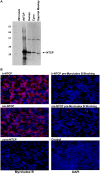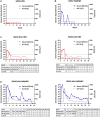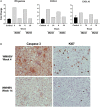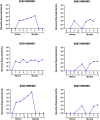Woolly Monkey-HBV Infection in Squirrel Monkeys as a Surrogate Nonhuman Primate Model of HBV Infection
- PMID: 32140655
- PMCID: PMC7049680
- DOI: 10.1002/hep4.1471
Woolly Monkey-HBV Infection in Squirrel Monkeys as a Surrogate Nonhuman Primate Model of HBV Infection
Abstract
Development of curative therapies for chronic hepatitis B virus (HBV) infection will likely require new animal models. Here, we evaluate HBV infection in squirrel monkeys based on the high-sequence homology of the HBV receptor, Na+/taurocholate co-transporting peptide (NTCP), between humans and squirrel monkeys. HBV PreS1 peptide was examined for binding human and squirrel monkey NTCP. Immunodeficient Fah -/- , NOD, Rag1 -/- , Il2Rg null (FNRG) mice engrafted with human or squirrel monkey hepatocytes were challenged with HBV or Woolly Monkey HBV (WMHBV). In addition, adult squirrel monkeys were inoculated with HBV, WMHBV, adeno-associated virus containing an infectious genome of HBV (AAV-HBV), and AAV-WMHBV. Finally, neonate squirrel monkeys were assessed for the potential of chronic infection with WMHBV. PreS1 peptide efficiently bound to human and squirrel monkey NTCP but not to mouse or capuchin NTCP. FNRG mice engrafted with squirrel monkey hepatocytes were susceptible to infection by WMHBV but not human HBV. Similarly, adult squirrel monkeys could be infected with WMHBV but not human HBV, whereas chimeric mice engrafted with human hepatocytes were susceptible to HBV but not WMHBV. Infection of squirrel monkeys with AAV-WMHBV yielded maximum viremia of 108 genomes/mL with detectable virus for up to 8 months. Notably, covalently closed circular DNA was detected in the liver of these animals. Infection of neonates with WMHBV led to detectable viremia for up to 6 months. Conclusions: Adult and neonate squirrel monkeys exhibited prolonged WMHBV viremia lasting 6-8 months. This is greater than twice the duration of viremia achieved in other nonhuman primates and suggests that squirrel monkeys may be a suitable model for testing HBV therapeutics.
© 2020 The Authors. Hepatology Communications published by Wiley Periodicals, Inc., on behalf of the American Association for the Study of Liver Diseases.
Figures







References
-
- Schweitzer A, Horn J, Mikolajczyk RT, Krause G, Ott JJ. Estimations of worldwide prevalence of chronic hepatitis B virus infection: a systematic review of data published between 1965 and 2013. Lancet 2015;386:1546‐1555. - PubMed
-
- Deng Q, Mancini‐Bourgine M, Zhang X, Cumont MC, Zhu R, Lone YC, et al. Hepatitis B virus as a gene delivery vector activating foreign antigenic T cell response that abrogates viral expression in mouse models. Hepatology 2009;50:1380‐1391. - PubMed
Grants and funding
LinkOut - more resources
Full Text Sources
Miscellaneous

